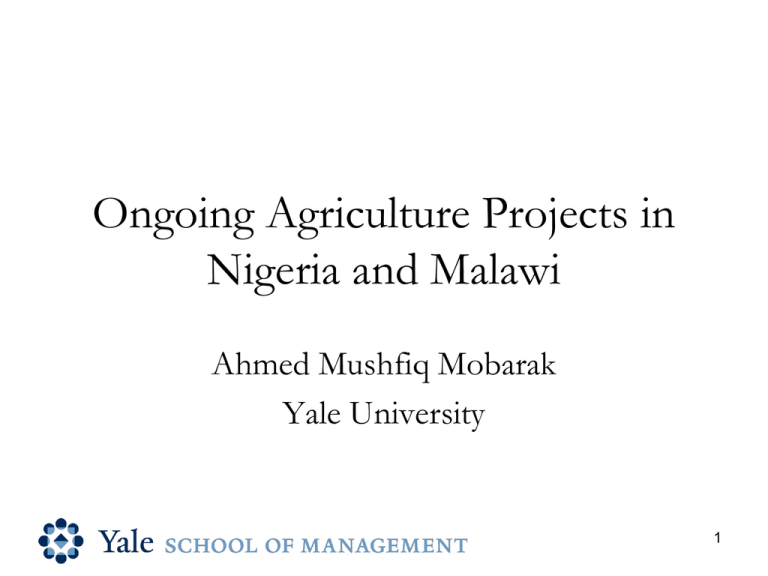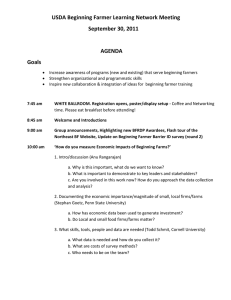Infrastructure for Agriculture: Water, Electricity, Roads
advertisement

Ongoing Agriculture Projects in Nigeria and Malawi Ahmed Mushfiq Mobarak Yale University 1 Difficult Question • What do we know about returns to investments in large infrastructure project, like water, electricity, roads? – Short Answer: Very little • So, why don’t we know much about the returns to investment in say, electricity? – We can contrast areas with and without electricity – We could compare areas before versus after getting a connection to the grid – Unfortunately, electricity grid placement is decidedly based on demand projections 2 ..but an important question • We need to be informed about whether to allocate funds to buying textbooks, or hiring nurses versus building roads or extending the electricity grid • In health, education we can design small-scale randomized evaluations. More difficult in infrastructure • Within CADP-Nigeria, it would be useful to know: – Is a $ spent on roads more effective than using the $ for input subsidies? (comparison of different strategies) – Is providing information to farmers about prices in different markets only useful if we also invest in roads that allow them to market their product (interaction effects of different strategies) 3 Evaluation Strategy – Randomize Timing • We will not randomize locations of roads, we will only build roads where they are appropriate. • Within the set of “appropriate” locations, we will randomize the timing of road building. • We are taking advantage of the fact that the project is being phased in over 5 years. • Imagine that 20% of planned project roads get built in year 1. Call these locations T1. • At the end of year 1, we can compare T1 outcomes to all other locations. • At the end of year 3, compare T1 and T2 to others 4 B A C D • Research Questions: – Effects of roads and electricity on household and farm outcomes – Effects of investment capital grants on technology and farm productivity – Interaction of grants and infrastructure availability • Identify set of feasible locations for road projects • At each location, define the intervention precisely in terms of spatial points that the road will go through and important entities it will connect (e.g. markets, communities, farms). Identify segments and feeder connections to specific farms 5 B A C D • Define the “catchment area” for the intervention encompassing all likely users of the road. This becomes our sampling frame. • Conduct a listing (i.e. rapid census) of all farms and households that fall within the sampling frame. Gather information on what farms each household owns and where. The spatial boundaries of the sampling frame may get re-defined slightly. • During the listing, ask a question to identify which farmers intend to apply to the investment capital grants, so that we can over-sample if necessary. 6 Data • We need to think carefully about what type of data to collect to effectively evaluate the project • Defining the “catchment area” for each road allowed us to decide where to conduct any surveys • Thinking through the mechanisms by which roads will affect outcomes allows us to learn: – Whom to survey (households, farmers, traders, or market level info like prices?) – What types of questions to ask them (e.g. school attendance may prove to be a primary benefit, even through commercial agriculture development was the ostensible purpose. 7 Baseline Information • We are typically not moving from a situation of “no roads” (i.e. zero communication/ transportation) to roads. • We are moving from a situation of lower quality transportation or worse access for farmers to a situation of higher quality or better access. • To evaluate the marginal change, we will need to have at least some information on baseline conditions • We can answer questions like – “Are roads most effective only in relatively isolated places, or are they equally effective everywhere?” 8 Technology Adoption in Malawi • Low productivity in agriculture is a pressing development challenge. – Food security issues – Intensifies use of scarce water – Intensifies use of land, leading to long-term sustainability concerns • We are trying to promote a “conservation agriculture” practice (pit planting) and better management of fertilizer among maize farmers in Malawi • Evaluation and Policy/Research Questions: – Effective strategies to communicate about new technologies to farmers – How do we convince farmers to adopt new technologies? 9 Evaluation Design Dissemination: Extension agent Peer Farmer Incentive for None Performance Incentive for None Performance Male Female Male Vary Male/Female composition of the set of Peer Farmers Control Incentive: Incentive for None Performance Technology Fertilizer Management Either Male or Female (natural Conservation variation) Agriculture Lead Farmer Female 10 Work Plan • 60 villages. Surveying 25 households per village (plus 5 peer farmer and 1 lead farmer) • Timeline: (worked backwards from ag season) – – – – Project conceived: April 2009 at Addis workshop Hired “project coordinator” in late May 2009. June 2009: country visit and placed PC in country June-July 2009: Convinced various groups within ministry (M&E, extension office, Ag research, and bosses) – Baseline survey in August – Sept-Nov 2009: • Trained extension workers • Community surveys to select lead and peer farms • On-farm monitoring strategy 11







